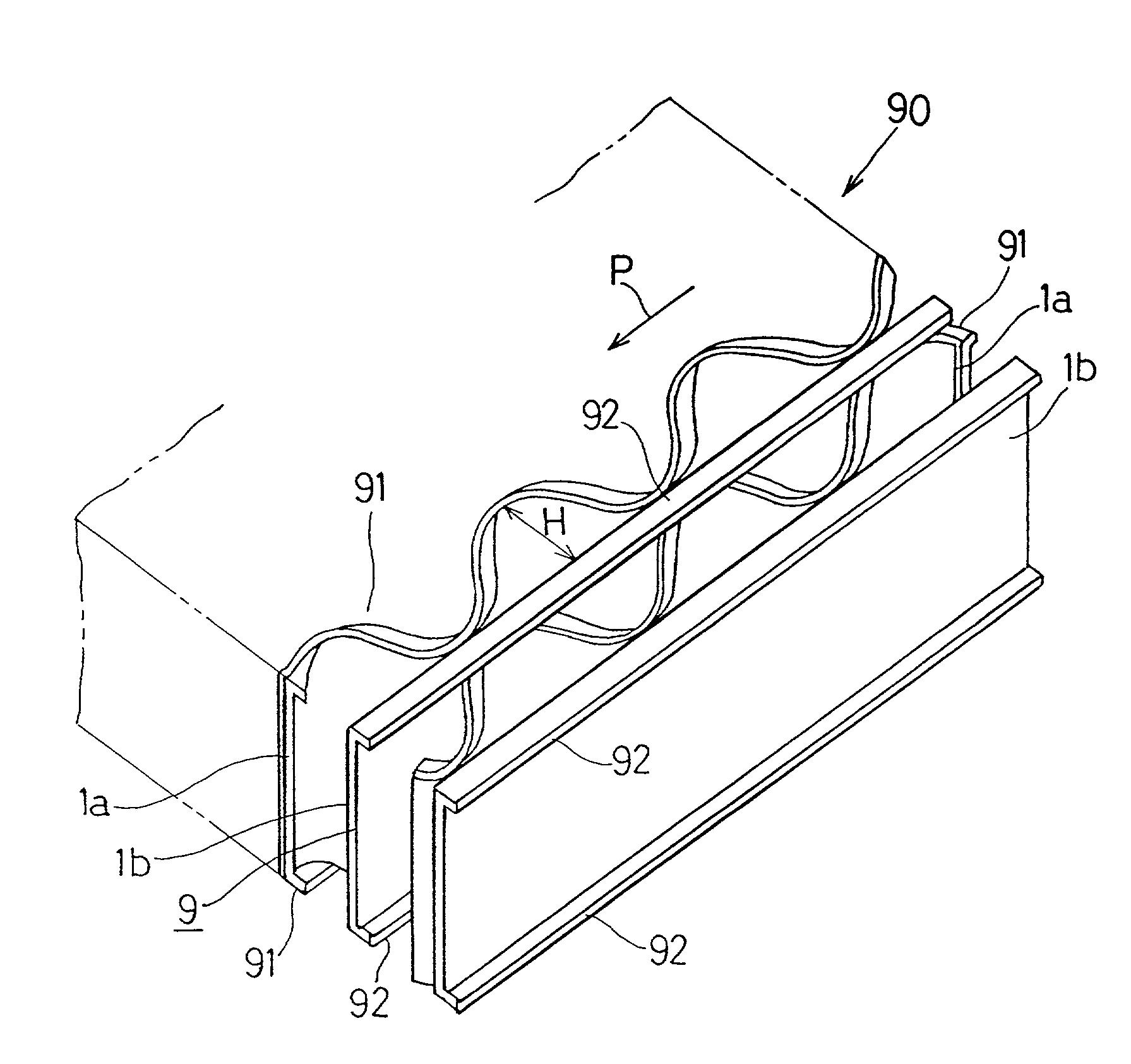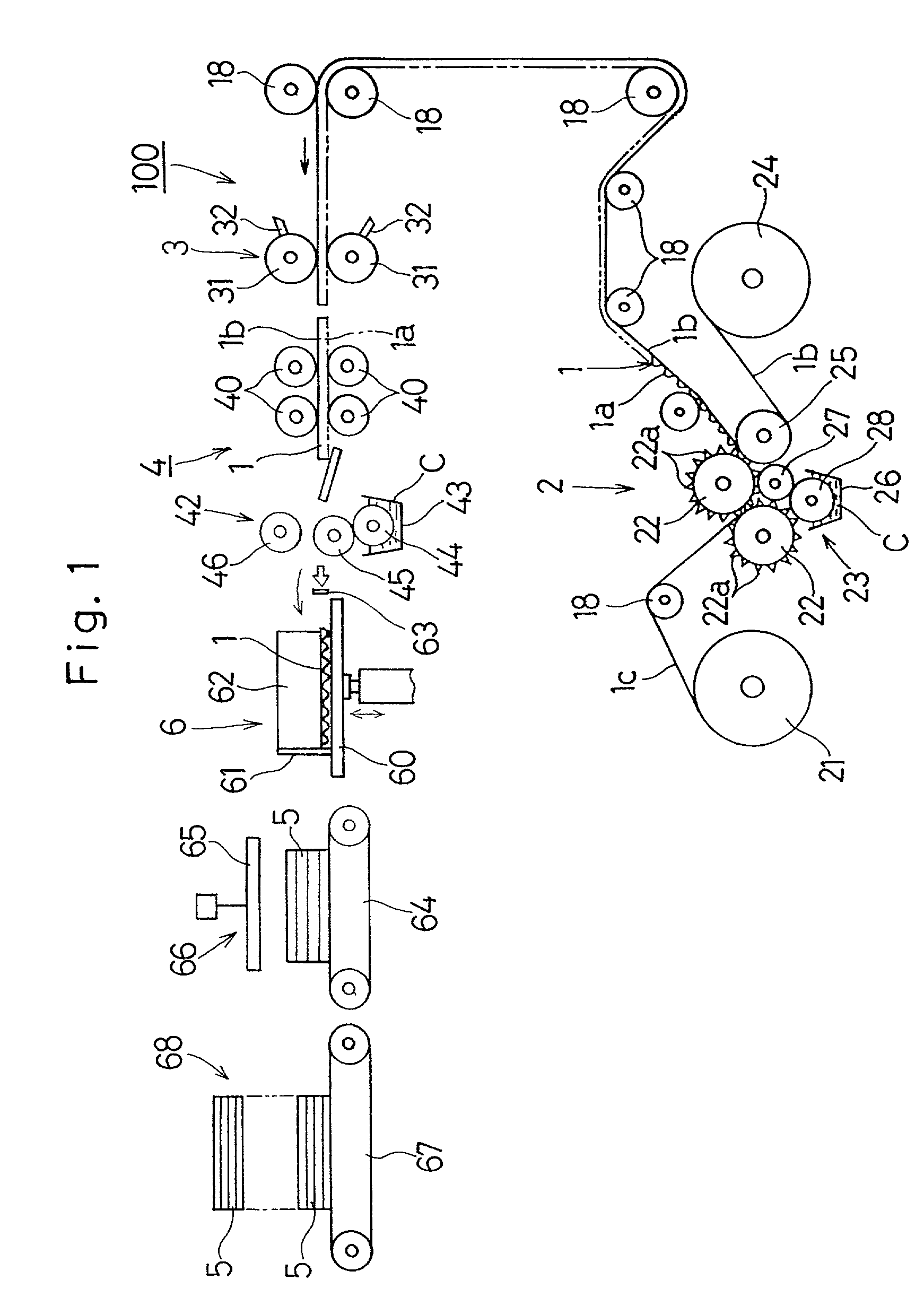[0009] With the above described corrugated cardboard plate making method, when the corrugated cardboard laminate is to be cut along cutting lines
lying perpendicular to
ridge lines of the corrugated sheet into a plurality of corrugated blocks, not a guillotine cutter including a single knife blade, but a
circular saw or a band saw including a body having its tip formed with rows of equally spaced saw teeth or a so-called raking saw having a plurality of equally spaced saw teeth that are alternately offset laterally relative to each other to provide two rows of alternating saw teeth, can advantageously be employed. In other words, since the corrugated cardboard laminate is of a design wherein corrugated cardboards are laminated together with the cells left open and does not require a relatively large force during the cutting thereof, the use of the
circular saw, the band saw or the
ranking saw is possible. For this reason, cut faces of each of the corrugated cardboard blocks resulting from cutting of the corrugated cardboard laminate can be suitably roughened and, therefore, by applying an
adhesive to the cut faces of each of the corrugated cardboard blocks optimally, the sheet can be assuredly and firmly bonded. Accordingly, no
surface roughening need not be performed with the use of the
surface roughening device and the expander such as required in the previously suggested apparatus. Accordingly, it is possible to continuously manufacture at a reduced cost the corrugated cardboard plates having excellent heat and sound insulations and being lightweight and robust and, yet, capable of exhibiting a performance comparable to or higher than that exhibited by the use of the honeycomb core material.
[0011] The corrugated cardboard plate making method of the present invention can easily be practiced by the use of the corrugated cardboard plate making apparatus of the structure described above.
[0012] In a preferred embodiment of the present invention, during the formation of the corrugated blocks or in the corrugated block former performing the formation of the corrugated blocks, bent portions are formed at opposite ends of the corrugated sheet, that are positioned on front and rear sides thereof, so as to extend in a direction parallel to the front and rear sides by means of cutting performed by a cutter. The presence of these bent portions is effective to increase the
physical strength of the corrugated sheet. Moreover, when the sheet is bonded to one or both of front and rear sides, the bonding surface area can increase because of the presence of the bent portions and, therefore, the
bonding strength of the sheet can be increased.
[0014] The corrugated cardboard plate of the present invention is excellent in heat insulation and sound insulation and, also, lightweight and has a strength and, therefore, can be used as a floor panel, a partition wall, an external wall, a
load bearing pallet, a core material for a table, a counter or a shelf, a core material for audio appliances or
office automation appliances, a
cushioning material for packages, a corner member for packaging, or a filter when filled with a
mass of
titanium oxide or
activated carbon particles, or an element for a
heat exchanger. Thus, the corrugated cardboard plate of the present invention can find a variety of applications.
[0016] In another preferred embodiment of the present invention, each of the bent portions has a length within the range of 1.0 to 5.0 times the thickness of the corrugated sheet. By so doing, the
physical strength of the corrugated cardboard plate can be increased and bonding of the sheet to the bent portions can be assuredly achieved. At this time, if the length of each of the bent portions is chosen to be of a value smaller than 1.0 times the thickness of the corrugated sheet, no sufficient physical strength can be obtained and no sufficient bonding of the sheet can also be obtained. On the other hand, if the length of each bent portion is chosen to be of a value greater than 5.0 times the thickness of the corrugated sheet, no simplified and efficient formation of the bent portions is possible. In other words, the corrugated cardboard plate is prepared by cutting corrugated cardboard laminates into a plurality of corrugated cardboard blocks by the use of a saw, which blocks are in turn connected together with upper and lower faces thereof bonded with each other. Therefore, if the bent portions are formed by the utilization of margins left at the cut ends of each of the corrugated cardboard block at the time of cutting by means of the saw, no separate manufacturing step is required and the bent portions can advantageously be formed simultaneously with the cutting. However, if the length of each of the bent portions exceeds a value greater than 5.0 times the thickness of the corrugated sheet, simultaneous formation of the bent portions with the cutting saw will become difficult. Accordingly, in order for the bent portions to be formed efficiently by the utilization of the manufacturing step of the corrugated cardboard plates, the length of each of the bent portion should be within the specific range as described above. Also, since the corrugated cardboard plate of the structure described above is excellent particularly in physical strength, it can be optimally utilized when used as material for the
load bearing pallet, the furniture or the core material for the rack.
 Login to View More
Login to View More 


